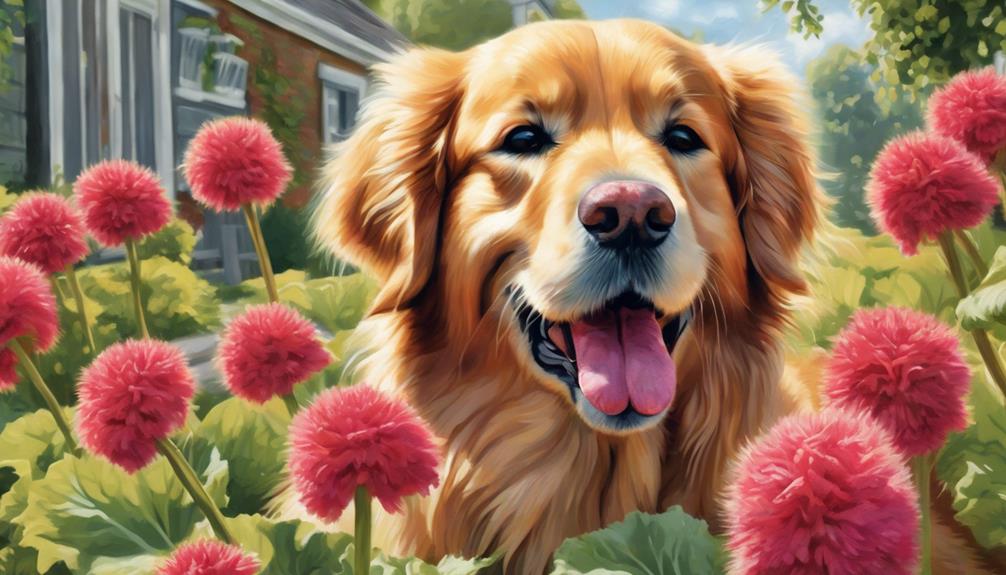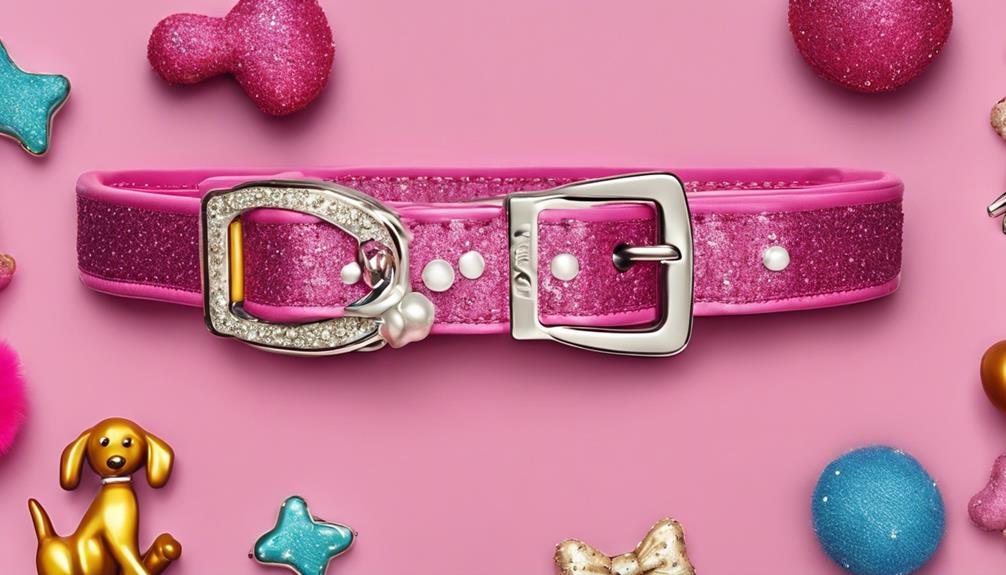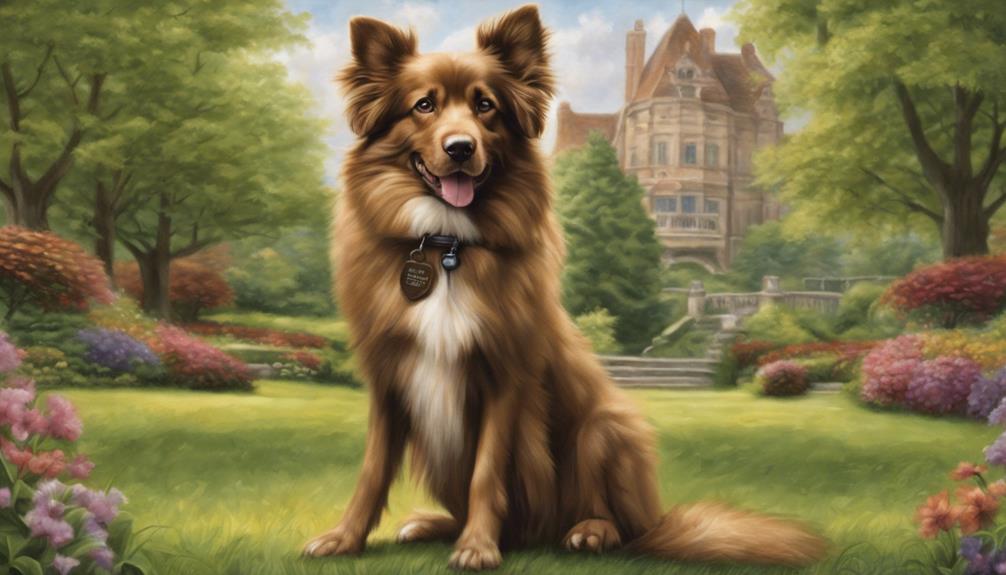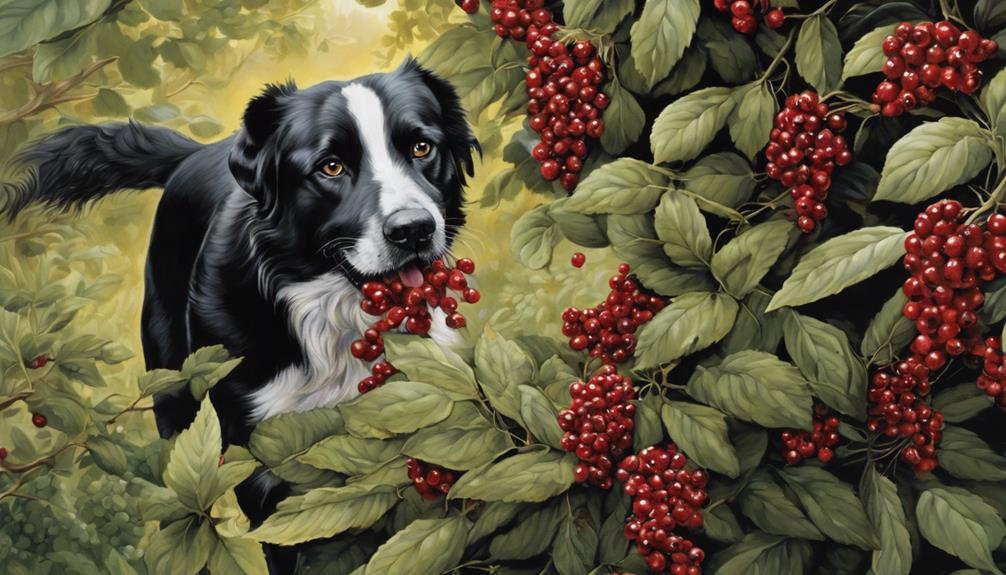Dogs can get sick from rhubarb, causing serious health problems. It's important for us to understand the risks of dogs eating rhubarb. Symptoms of rhubarb poisoning include mouth and throat pain, as well as breathing trouble. Make sure rhubarb plants are out of reach and train dogs to avoid harmful plants. If you suspect ingestion, go to the vet right away. Treatment involves inducing vomiting and using activated charcoal. Immediate help is essential to prevent kidney damage. Being informed about rhubarb poisoning in dogs is critical. More valuable information is waiting to be discovered.
Key Takeaways
- Rhubarb is toxic to dogs, causing mouth pain, inflammation, and breathing difficulties.
- Prevent rhubarb poisoning by keeping plants out of reach and training dogs to avoid harmful plants.
- Symptoms of rhhubarb poisoning include drooling, weakness, loss of appetite, and lethargy.
- Immediate vet care is crucial if ingestion is suspected to prevent kidney damage.
- Healthy dog treats are important for overall health, immunity, coat quality, and dental care.
Rhubarb Poisoning Symptoms in Dogs
When dogs ingest rhubarb, they may exhibit symptoms of poisoning that include mouth and throat pain, inflammation, and difficulty breathing. Rhubarb contains oxalate crystals, which are toxic to dogs and can lead to serious health issues. These crystals cause irritation and damage to the mouth and throat, resulting in pain and inflammation. Additionally, if the crystals are ingested in large quantities, they can lead to difficulty breathing, making it vital to seek immediate veterinary care if you suspect your dog has consumed rhubarb.
Oxalate crystals in rhubarb can also contribute to renal failure in dogs, further highlighting the importance of recognizing and addressing symptoms of rhubarb poisoning promptly. If your dog shows signs of mouth and throat pain, inflammation, or difficulty breathing after ingesting rhubarb, it's essential to seek professional help. Remember, early detection and intervention are key in ensuring the well-being of your furry friend when faced with potential toxic exposure to rhubarb.
Preventive Measures for Rhubarb Ingestion
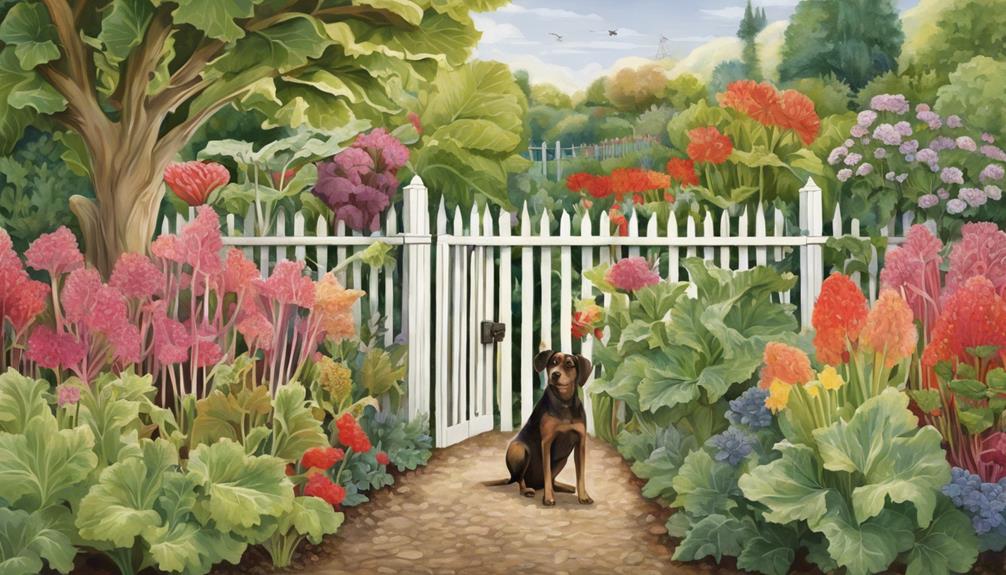
When it comes to safeguarding our furry friends from rhubarb ingestion, there are a few key steps to remember.
First, make sure rhubarb plants are placed out of your dog's reach to prevent accidental consumption.
Second, train your dog to avoid harmful plants like rhubarb using positive reinforcement techniques.
Rhubarb Toxicity Symptoms
To prevent rhubarb toxicity in dogs, it's essential to be aware of the symptoms and take immediate preventive measures upon ingestion. Rhubarb is toxic to pets due to the presence of calcium oxalate, which can lead to various symptoms. Here are some precautionary steps to keep in mind:
- Monitor for Symptoms: Keep an eye out for signs such as drooling, weakness, tremors, and changes in thirst and urination.
- Induce Vomiting: If ingestion occurs, induce vomiting to eliminate the toxins from the system.
- Administer Activated Charcoal: Give activated charcoal to help absorb any remaining toxins in the stomach.
- Consult a Vet: Seek immediate veterinary assistance for further treatment options and care.
Being proactive and informed can help safeguard your furry friend's health.
Treatment Options Available
Implementing preventive measures is essential in ensuring dogs are kept safe from the dangers of rhubarb ingestion. Rhubarb is a toxic plant that can lead to kidney failure in dogs if ingested. To prevent this, keep rhubarb plants out of reach of your furry friends.
Training dogs to steer clear of harmful plants like rhubarb can also help avoid ingestion. Be cautious with food scraps containing rhhubarb, as accidental consumption can occur.
Supervise your dogs in areas where rhubarb grows to prevent access. These simple steps can greatly reduce the risk of rhubarb ingestion and the associated health issues. Remember, quick action is vital in protecting your pet's well-being.
Consult Veterinarian Immediately
Taking prompt action by consulting a veterinarian is essential when a dog has potentially ingested rhubarb to prevent serious health complications. If your dog has consumed rhubarb leaves, immediate veterinary assistance is vital to avoid kidney damage.
Here are four preventive measures to safeguard your furry friend:
- Consult a Veterinarian: Seek professional guidance promptly.
- Avoid Delay: Time is of the essence in such cases.
- Provide Relevant Information: Share details about the quantity and time of ingestion.
- Consider Calcium: In some cases, calcium can help reduce the absorption of toxins.
Treatment Options for Rhhubarb Poisoning
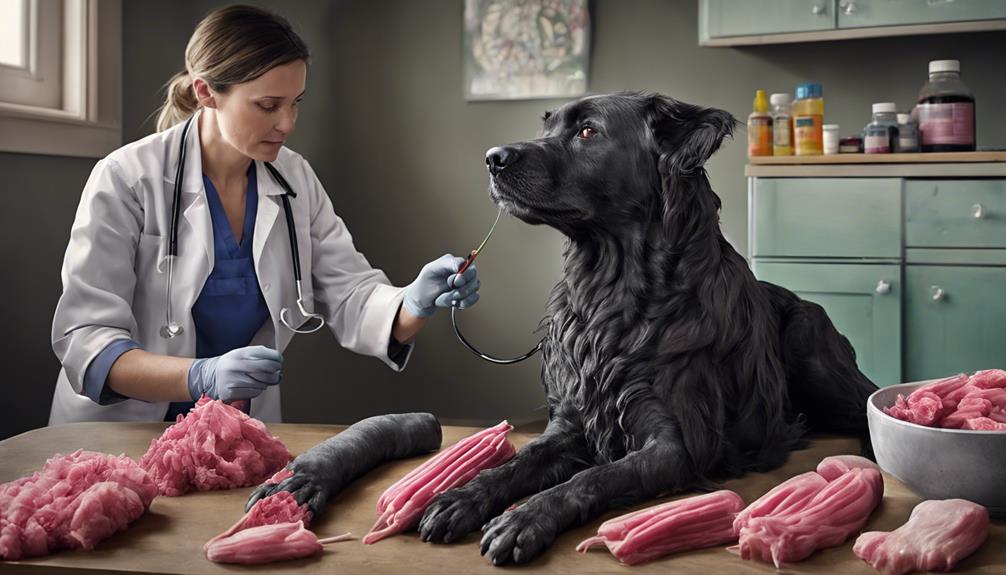
When a dog shows symptoms of rhubarb poisoning, such as drooling or vomiting, immediate veterinary care is vital.
In severe cases, complications like kidney failure can arise, emphasizing the importance of prompt treatment.
Understanding the potential complications and acting swiftly can greatly improve the chances of a positive outcome for your furry friend.
Symptoms of Poisoning
In cases of rhubarb poisoning in dogs, recognizing the symptoms promptly is essential for initiating appropriate treatment. Symptoms may include drooling, loss of appetite, weakness, tremors, and changes in thirst and urination.
To address rhubarb poisoning in dogs effectively, consider the following treatment options:
- Inducing vomiting: This can help remove the ingested rhubarb from the system.
- Administering activated charcoal: This aids in absorbing toxins present in the digestive tract.
- Providing IV fluids for toxin elimination: Fluid therapy supports the body in flushing out toxins.
- Monitoring calcium levels: Rhubarb poisoning can affect calcium levels, requiring close monitoring for proper treatment.
Being aware of these symptoms and treatment options is critical in ensuring the well-being of dogs that have ingested rhubarb.
Immediate Veterinary Care
For immediate veterinary care in cases of rhubarb poisoning, our primary focus is on inducing vomiting or administering activated charcoal to counteract toxin ingestion. Rhubarb contains oxalic acid, which can be harmful to dogs when consumed in large amounts. Inducing vomiting helps expel any remaining rhubarb from the stomach, reducing further absorption of toxins.
Activated charcoal works by binding to the toxins in the gastrointestinal tract, preventing them from being absorbed into the bloodstream. These treatment options aim to minimize the effects of rhubarb poisoning and support the dog's recovery.
If your dog ingests rhubarb, seeking immediate veterinary care is essential. Consider having pet insurance to help cover the costs of unexpected emergencies like rhubarb poisoning.
Potential Complications
To address potential complications of rhubarb poisoning in dogs, treatment options such as inducing vomiting, administering activated charcoal, and providing IV fluids are vital. When dealing with soluble calcium oxalate ingestion, managing low blood calcium levels is essential. Here are four key steps in treating rhubarb poisoning complications:
- Inducing Vomiting: This helps remove any remaining rhubarb from the stomach.
- Administering Activated Charcoal: It binds to toxins, preventing further absorption.
- IV Fluids: These help flush out toxins and maintain hydration.
- Monitoring Calcium Levels: Essential for preventing complications associated with low blood calcium levels.
Safe Treat Alternatives for Dogs
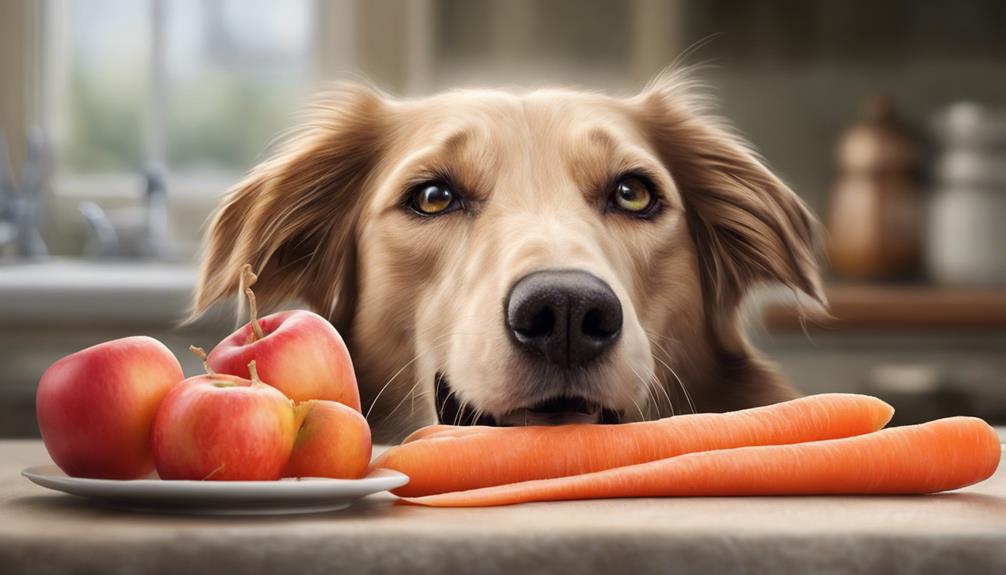
What're some safe and healthy alternatives for treating dogs?
When it comes to rewarding your furry friend, there are various options that aren't only secure but also enjoyable for them. Fruits like apples, bananas, and blueberries can make delicious treats for dogs. These fruits aren't only tasty but also packed with essential nutrients that can benefit your dog's health. Additionally, vegetables such as carrots and green beans are excellent choices for dogs, providing them with essential vitamins and fiber.
If you prefer a more convenient option, commercial dog treats are readily available and secure for dogs. These treats come in a variety of flavors and sizes, catering to different preferences and dietary needs. For those who enjoy getting creative in the kitchen, making homemade treats using dog-friendly recipes can be a fun and rewarding experience. By consulting with a vet, you can make sure that the treats you choose are suitable for your dog's specific needs and preferences. Remember, treating your dog should be a pleasurable experience for both you and your furry companion.
Recognizing Signs of Poisoning in Dogs
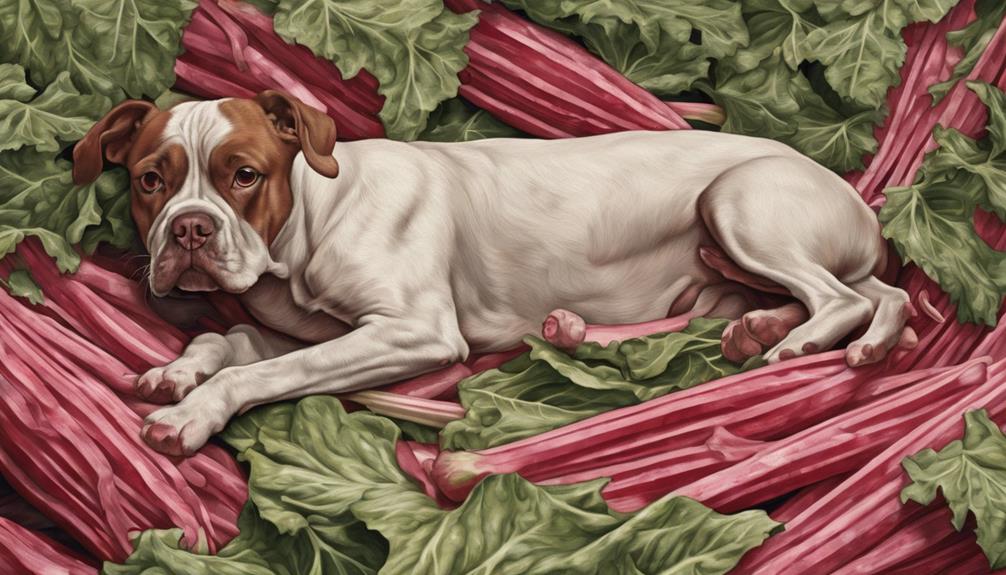
Exploring the signs of poisoning in dogs reveals important information for pet owners to guarantee their furry companions' well-being. When it comes to recognizing signs of poisoning in dogs, it's essential to be alert and observant to protect your pet.
Here are four key signs to watch out for:
- Drooling: Excessive drooling can be an indication that your dog has ingested something toxic, such as rhubarb.
- Loss of Appetite: If your dog suddenly loses interest in food or treats, it could suggest poisoning and shouldn't be ignored.
- Weakness and Lethargy: A noticeable decrease in energy levels or overall weakness may indicate that your dog is experiencing poisoning symptoms.
- Sudden Drop in Calcium Levels: Keep an eye out for symptoms like tremors and changes in thirst and urination, as these can suggest a sudden drop in calcium levels, which could be caused by plant poisoning.
Being aware of these signs can help you act promptly to make sure your dog receives the necessary care in case of poisoning.
Immediate Veterinary Help for Dogs
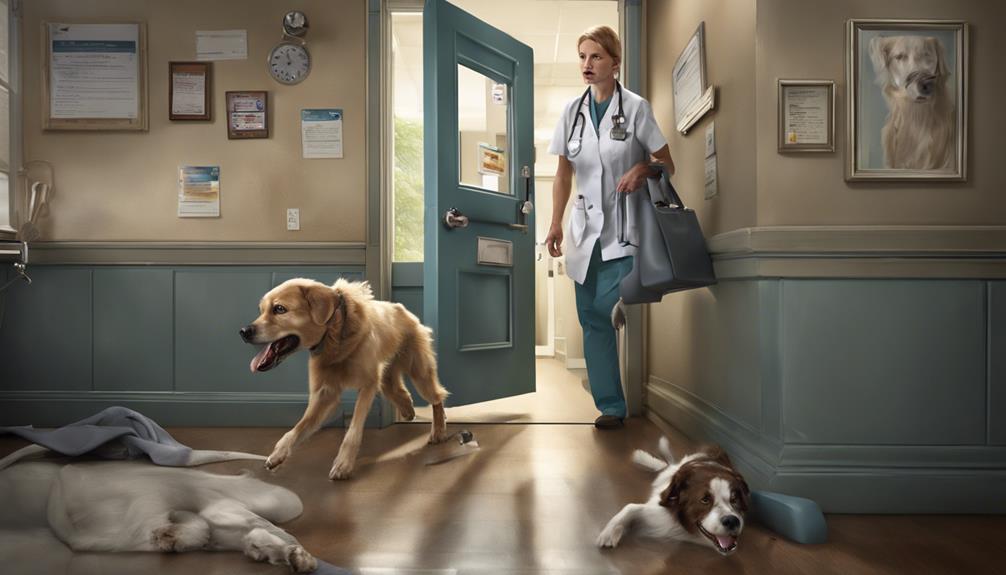
Seeking immediate veterinary assistance is essential when a dog has ingested rhubarb leaves. Rhubarb toxicity can lead to symptoms like drooling, vomiting, diarrhea, weakness, and tremors in dogs.
The soluble calcium oxalate crystals present in rhubarb leaves are particularly critical as they can cause kidney failure and lower blood calcium levels in our furry friends. When faced with such a situation, it's important to get professional veterinary help promptly.
The vet may induce vomiting to remove the ingested rhubarb, administer activated charcoal to help absorb any remaining toxins, and closely monitor the dog's calcium levels to prevent any complications. Time is of the essence in such cases, so don't hesitate to contact your vet or an emergency animal clinic if you suspect your dog has ingested rhubarb leaves.
Dangers of Rhubarb Ingestion
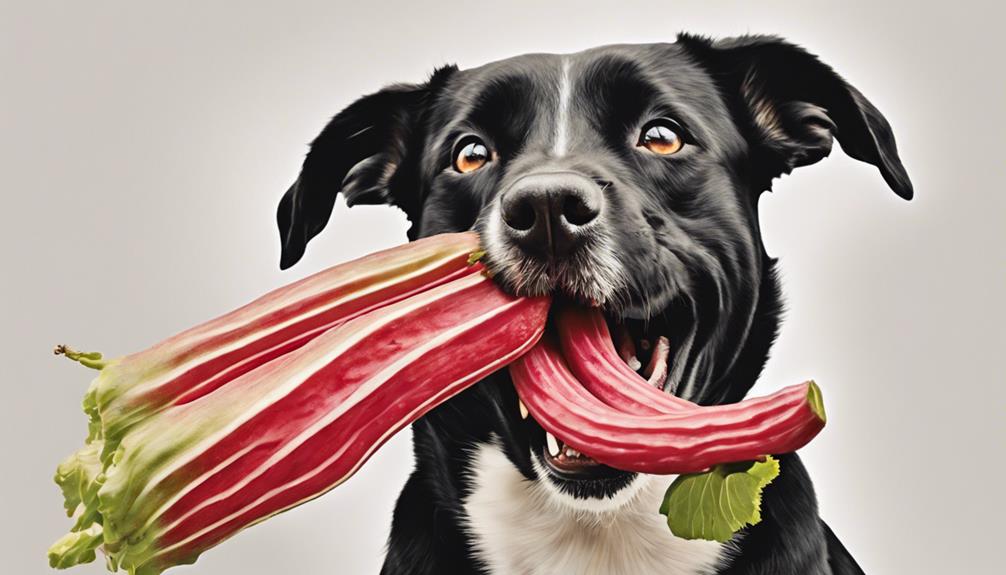
After addressing immediate veterinary concerns for dogs who've ingested rhubarb, understanding the dangers of rhubarb ingestion becomes essential.
- Soluble Calcium Oxalate: Rhubarb toxicity in dogs is primarily caused by soluble calcium oxalate crystals present in the rhubarb plant. These crystals can lead to severe health issues if ingested.
- Renal Failure Risk: Ingesting any part of the rhubarb plant can potentially result in renal failure in dogs. This organ failure can be life-threatening and requires immediate medical attention.
- Symptoms of Poisoning: Dogs experiencing rhubarb poisoning may exhibit symptoms such as mouth and throat pain, inflammation, and difficulty breathing. Recognizing these signs early is critical for prompt treatment.
- Veterinary Intervention: Veterinary tests like blood count and urinalysis can help confirm the presence of soluble calcium oxalate and assess the dog's renal function. Timely intervention and appropriate treatment can improve the chances of a successful recovery.
Understanding these dangers empowers us to take proactive steps in preventing rhubarb ingestion and safeguarding our furry friends' well-being.
Importance of Healthy Dog Treats
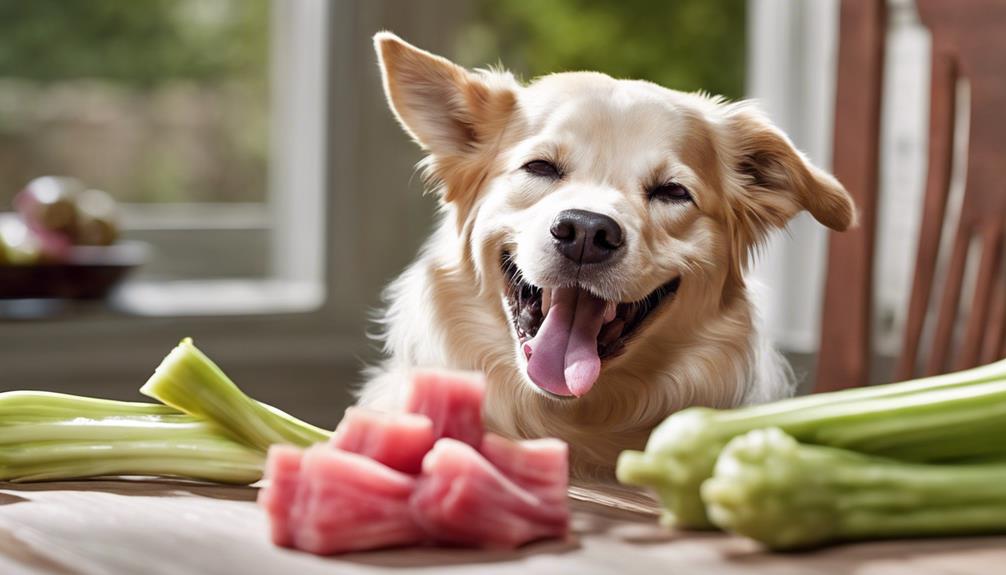
Choosing nutritious dog treats is crucial for your pet's health and well-being. Dogs need a balanced diet that includes high-quality treats to maintain a healthy weight and prevent obesity. Treats made with natural ingredients can boost your dog's immune system and promote a shiny coat. Avoid treats with artificial additives or excessive sugars to prevent dental issues. Offering a variety of healthy treats keeps your dog engaged and satisfied during training sessions while providing essential nutrients for a happy, active life. Just as we choose the best for ourselves, selecting wholesome treats shows love and care for our furry friends.
Frequently Asked Questions
What Do I Do if My Dog Eats Rhubarb?
If your dog eats rhubarb, immediate rinsing with cool water can help. Providing cool food or drink can ease pain and irritation. Mild cases may only need mouth rinsing and pain relief. Larger ingestions may require vet evaluation, IV fluids, and toxin removal. Antihistamines and gastroprotective meds may be given.
Always seek veterinary advice if concerned about rhubarb consumption, as it can be harmful to pets.
What Are the Symptoms of Rhubarb Poisoning?
Rhubarb poisoning in dogs presents with symptoms like mouth and throat pain, inflammation, and breathing difficulties. This can lead to renal failure if the body absorbs the toxins. Immediate signs such as oxalate crystals aid in detection.
Veterinary tests, including blood counts and urinalysis, confirm the toxin's presence and assess kidney function. Vomiting of plant material often confirms rhubarb poisoning. If your dog shows these symptoms, seek immediate veterinary care.
Are Dogs Attracted to Rhubarb?
Yes, dogs can be attracted to rhubarb for various reasons. The unique scent and bright colors of rhubarb may catch a dog's attention, leading them to investigate the plant out of curiosity.
Some dogs may be drawn to the texture of rhubarb leaves, mistaking them for a chew toy or snack. It's important to prevent dogs from consuming rhubarb as it can be harmful and toxic to their health.
Is Rhubarb Toxic to Dogs or Cats?
Rhubarb is harmful to dogs and cats due to soluble calcium oxalate crystals. Ingesting rhubarb can cause digestive problems, kidney damage, and neurological symptoms in pets. The leaves are particularly hazardous and should be kept away from animals.
Symptoms of rhubarb toxicity include excessive saliva, throwing up, weakness, and shaking. Immediate veterinary care is vital if a pet consumes rhubarb to prevent severe health issues.
Conclusion
To sum up, remember that dogs and rhubarb don't mix well. Keep your furry friends safe by preventing them from ingesting this potentially harmful plant.
If you suspect your dog has eaten rhubarb, seek immediate veterinary assistance to guarantee their well-being.
Stick to safe treat alternatives and always be vigilant when it comes to what your dog eats. Your pet's health is worth the extra caution.
Stay informed and keep those tails wagging!
